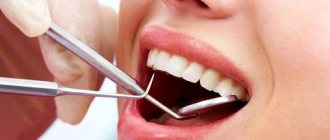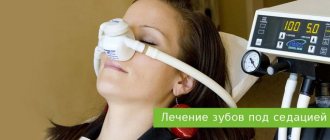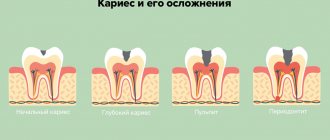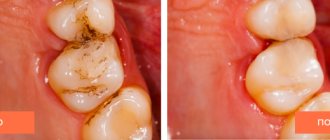Anesthesia methods in dentistry
All methods of anesthesia in dentistry are divided into general and local. General anesthesia is general anesthesia and intravenous sedation. That is, drugs are used that affect the entire body, and not just the oral cavity. This is a standard general anesthesia that is used not only in dentistry, but also in other branches of medicine. Local anesthesia is the familiar “freezing”, administered by injection. Xenon therapy can also be used in combination with general or local anesthesia.
Local anesthesia is most often used in dentistry. There are many indications for its use. These include:
- cleaning teeth from deposits;
- dental treatment of any complexity;
- removal of dental units;
- performing manipulations on the gums;
- surgical manipulations in the oral cavity;
- implantation or preparatory measures (but in some cases general anesthesia is recommended).
Local anesthesia has obvious advantages. The drugs are safe, they do not negatively affect the body, do not cause side effects and are eliminated quickly. At the same time, the techniques completely relieve pain of any nature.
Local application of anesthetics involves the use of special syringes with a very thin needle to avoid pain during injection. Main types of local anesthesia:
- Applique. It involves applying a pain-relieving anesthetic in the form of a gel. It is used primarily for oral hygiene and removal of deposits, especially if ultrasound is used for this. Its effect is short-lived.
- Infiltration. This is the standard injection “freezing”, which is carried out in almost all procedures. The injection can be injected into the mucosal tissue, bone or periosteum. In this case, the dentist must take into account the anatomy of the upper and lower jaw.
- Conductor. Used for long and complex surgical interventions. An anesthetic with a high content of the active component is selected. It is injected directly into the nerve, so the effects of anesthesia last longer and affect a larger area. Conductive anesthesia can be used during operations, tooth extraction, and when installing several implants at the same time.
What is anesthesia?
The procedure for injecting special drugs aimed at eliminating local sensitivity is called anesthesia. The active substance of the anesthetic blocks the conduction of impulses from nerve endings to the brain, preventing the occurrence of pain in response to manipulations. After the anesthetic wears off, sensitivity is completely restored.
Today in dentistry there are several types of local anesthesia. The most commonly used anesthesia is an injection into the area of one tooth. Other methods are aimed at “switching off” the nerves of several teeth at once.
The anesthesia procedure allows you to avoid discomfort during dental procedures, which is why anesthesia is used everywhere during the treatment and extraction of teeth.
Anesthesia does not work: what to do?
Situations where anesthesia does not work are extremely rare. Less than 1 percent of patients are sensitive to a particular drug, so choosing the right type of anesthesia is key. Frequent reasons for effectiveness are incorrectly selected dosage of the anesthetic or errors in its administration.
When using anesthesia, you must take into account the following health conditions:
- If you are prone to allergies, asthma or diabetes, medications without preservatives and with a low concentration of epinephrine are used. The funds are selected individually, taking into account the analysis.
- For heart pathologies and high blood pressure, medications with a minimum of epinephrine or without it are used. Also, they should not contain adrenaline. In these cases, xenon therapy or intravenous sedation may be used.
- For pregnant and lactating women, epinephrine dosages should be kept to a minimum. Then it cannot cross the placenta and enter breast milk.
Sedation and anesthesia are completely safe if performed by an experienced specialist. When carrying out long and complex interventions, such as implantation or prosthetics, sedation is even a recommended method, since the operation becomes more comfortable for the patient.
Our doctors select anesthesia individually. We offer all types of dental services: whitening, cleaning, surgical and therapeutic treatment for adults and children, installation of crowns, veneers and dentures. You can find out the clinic’s prices and make an appointment through the website or by phone.
Difficulty in achieving pulp anesthesia in mandibular teeth
Author: Unni Krishnan
Translation: Gavryushina Anna
Failure to obtain adequate pulpal anesthesia is the most common adverse outcome of local anesthesia in endodontics and is often associated with the administration of mandibular anesthesia. Although it goes without saying that absence of lip numbness is a clear sign of absence of pulpal anesthesia, absence of pulpal anesthesia may occur despite the presence of lip numbness, especially in mandibular posterior teeth with symptomatic irreversible pulpitis. Lack of pulpal anesthesia is often objectively verified as failure to obtain two consecutive readings of 80 using an electrical pulp tester or after prolonged application of a cold stimulus. However, every endodontist knows that the pulp can be sensitive even if these tests confirm complete anesthesia. Many studies have shown the inadequacy of mandibular anesthesia to provide sufficient pulpal anesthesia for restoration of about 50% of healthy anterior teeth, which should be anesthetized with mandibular anesthesia. The depth of pulpal anesthesia will decrease with pulpitis and other local factors.
Lack of lip numbness is a sign of improper anesthesia technique and is reported to occur in 5-23% of cases. Although lip numbness usually occurs 4–6 minutes after mandibular anesthesia, pulpal anesthesia in the mandibular first molar usually takes longer (up to 9 minutes). Lower central incisors may require more time (up to 19 minutes). In addition, 12–20% of patients may experience a slow onset of pulpal anesthesia, as determined by electrical pulp test readings occurring after 15 minutes. Thus, sufficient time must be allowed for pulpal anesthesia to develop before endodontic treatment begins. The slower onset in the anterior teeth must be taken into account when treating these teeth, although the latter can be anesthetized by vestibular infiltration.
Poor technique, failure to identify landmarks, insufficient dosage, and anatomical features such as bifurcation of the mandibular nerve canal are often cited as reasons for lack of lip numbness. Failure to identify three critical landmarks, namely the coronal notch, the pterygomaxillary suture, and the occlusal plane of the mandibular teeth, is the most common reason for failure of mandibular anesthesia. Many anxious patients open their mouth halfway and push their jaw forward. Surprisingly, one of the main reasons for failure of mandibular anesthesia is the identification of injection landmarks when the mouth is not fully open. Injections performed in this position of the jaw often result in the solution being injected ineffectively: distal and below the mandibular nerve. Perhaps the single most important addition to the administration of mandibular anesthesia is to ensure that patients open their mouths "as wide as they can" before receiving the injection. Ask pa
Dentist advice
Osmanov Konstantin Gennadievich
Discuss concerns about the procedure with your dentist. Ask questions about medications used for pain and what to expect during and after treatment. Get a medical history from your physician, including information about allergies and other medications you take, including over-the-counter and prescription medications and dietary supplements.
The influence of chemicals on the process of pain relief
Alcohol and drugs have always had a devastating effect on human health. Some people, in order to block fear, drink strong alcoholic drinks before visiting the dental office. Due to the presence of alcohol in the blood, anesthesia may not work. This happens due to blockage of nerve fibers.
There is another good reason for refusing to combine alcohol and painkillers - these are possible problems with blood clotting. Alcohol thins it, making it harder to stop bleeding. Consequently, the treatment procedure is complicated.
Types of anesthesia, how it is done
The dentist can use application, infiltration and conduction anesthesia. In each case there will be a different depth of impact. Accordingly, anesthesia after tooth extraction will weaken, depending on the location of exposure and the concentration of the drug.
- The application type of anesthetic is a solution or gel that is applied to the surface of the mucous membranes. The effect is on receptors in the mouth and peripheral nerve endings. This type of anesthesia is used to relieve pain before injections, as well as when removing children's baby teeth.
- Infiltration is a shallow injection that allows you to locally “freeze” the peripheral nerves. This is the option most often used for dental treatment, extractions and simple surgical interventions.
- The conduction type of anesthesia allows you to “turn off” nerve channels and trunks. When it is necessary to desensitize half of the jaw, this option is used. It is used for tooth extraction, surgical interventions, and severe inflammatory processes. The injection is performed closer to the temporomandibular joint, in the branch of the trigeminal nerve.
Anesthetic for applications - a solution or gel applied to the mucous membranes
In complex cases, when the patient is treated using sedation with analgesia or general anesthesia, the anesthesiologist is responsible for deactivating the effects of the drugs. In this case, there is an effect on the central nervous system, suppressing not only the patient’s consciousness, but also all reflexes. General anesthesia after tooth extraction is completely removed within 24 hours. After such manipulations, the patient is transferred to intensive care, where he is under the supervision of specialists.
How long should it take to freeze?
How long does anesthesia last after tooth extraction? The duration of the effect depends on several factors:
- The type and amount of pain medication administered;
- Type of anesthesia, injection depth, injection site;
- The presence of a vasoconstrictor in the drug (substances that constrict blood vessels and prolong pain relief);
- Human weight, individual parameters;
- Features of metabolism;
- The presence of chronic diseases of the urinary system.
Conduction anesthesia lasts 2-3 hours on the upper jaw and 3-5 hours on the lower jaw. Therefore, the pain relief effect may persist for several hours after visiting the doctor. Other types of local anesthesia have a shorter period of action - from 15 minutes to 2 hours.










